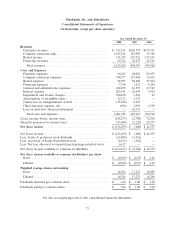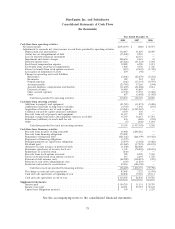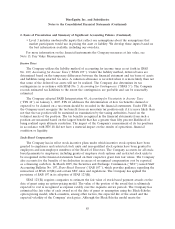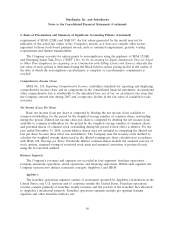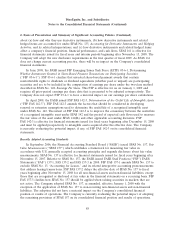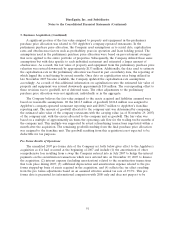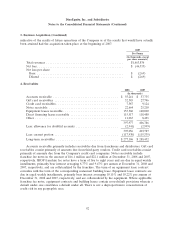IHOP 2008 Annual Report Download - page 96
Download and view the complete annual report
Please find page 96 of the 2008 IHOP annual report below. You can navigate through the pages in the report by either clicking on the pages listed below, or by using the keyword search tool below to find specific information within the annual report.DineEquity, Inc. and Subsidiaries
Notes to the Consolidated Financial Statements (Continued)
2. Basis of Presentation and Summary of Significant Accounting Policies (Continued)
Leases
The Company leases the majority of all IHOP restaurants. The restaurants are subleased to IHOP
franchisees or in a few instances are operated by the Company. The Company’s IHOP leases generally
provide for an initial term of 15 to 25 years, with most having one or more five-year renewal options at
the Company’s option. In addition, the Company leases a majority of its company-operated Applebee’s
restaurants. Franchisees are responsible for financing their properties. The Applebee’s company-
operated leases generally have an initial term of 10 to 20 years, with renewal terms of 5 to 20 years,
and provide for a fixed rental plus, in certain instances, percentage rentals based on gross sales. The
rental payments or receipts on leases that meet the operating lease criteria are recorded as rental
expense or rental income. Rental expense and rental income for these operating leases are recognized
on the straight-line basis over the original terms of the leases. The difference between straight-line rent
expense or income and actual amounts paid or received represents deferred rent and is included in the
balance sheets as other assets or other liabilities, respectively.
The rental payments or receipts on those property leases that meet the capital lease criteria will
result in the recognition of interest expense or interest income and a reduction of capital lease
obligation or financing lease receivable. Capital lease obligations are amortized based on the
Company’s incremental borrowing rate and direct financing leases are amortized using the implicit
interest rate.
The lease term used for straight-line rent expense is calculated from the date the Company obtains
possession of the leased premises through the lease termination date. The Company expenses rent from
possession date through restaurant open date as expense. Once a restaurant opens for business, the
Company records straight-line rent over the lease term plus contingent rent to the extent it exceeded
the minimum rent obligation per the lease agreement. The Company uses a consistent lease term when
calculating depreciation of leasehold improvements, when determining straight-line rent expense and
when determining classification of its leases as either operating or capital. For leases that contain rent
escalations, the Company records the total rent payable during the lease term, as determined above, on
the straight-line basis over the term of the lease (including the rent holiday period beginning upon our
possession of the premises), and records the difference between the minimum rents paid and the
straight-line rent as a lease obligation. Certain leases contain provisions that require additional rental
payments based upon restaurant sales volume (‘‘contingent rent’’). Contingent rentals are accrued each
period as the liabilities are incurred, in addition to the straight-line rent expense noted above.
Certain lease agreements contain tenant improvement allowances, rent holidays, and lease
premium, which are amortized over the shorter of the estimated useful life or lease term. For tenant
improvement allowances, the Company also records a deferred rent liability or an obligation in our
non-current liabilities on the consolidated balance sheets and amortizes the deferred rent over the term
of the lease as a reduction to company restaurant expenses in the consolidated statements of earnings.
Preopening Expenses
Expenditures related to the opening of new or relocated restaurants are charged to expense when
incurred.
82



